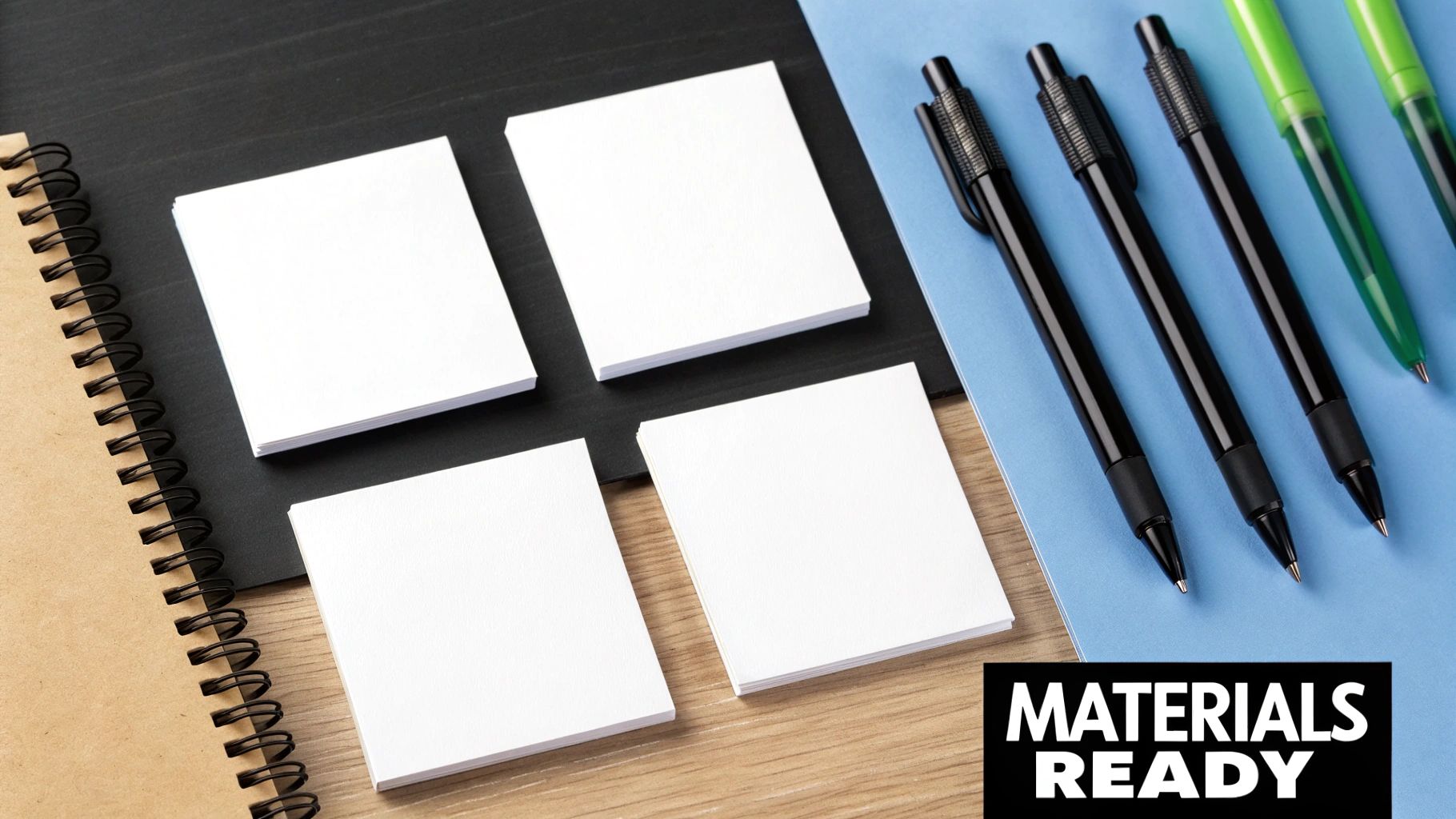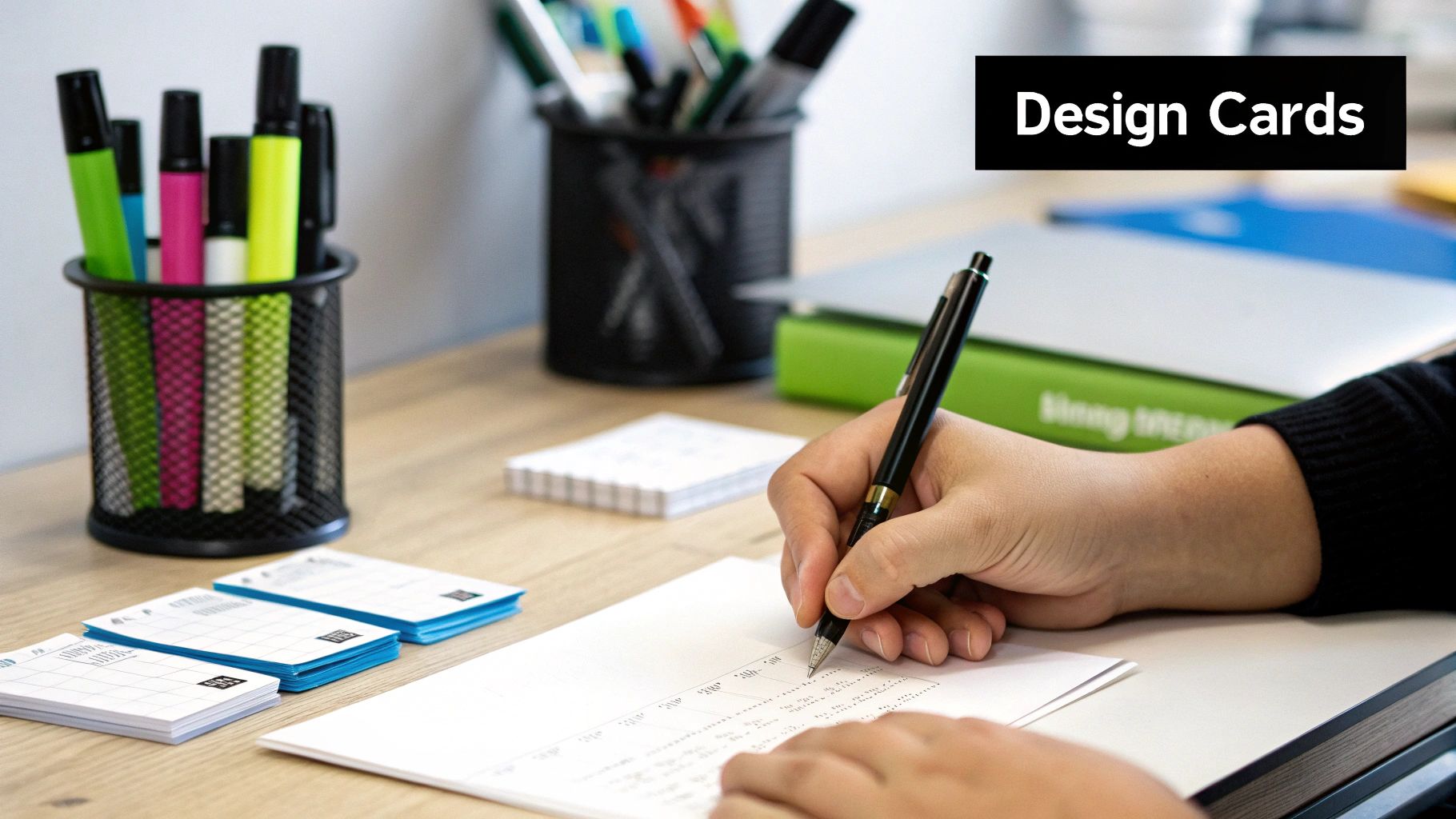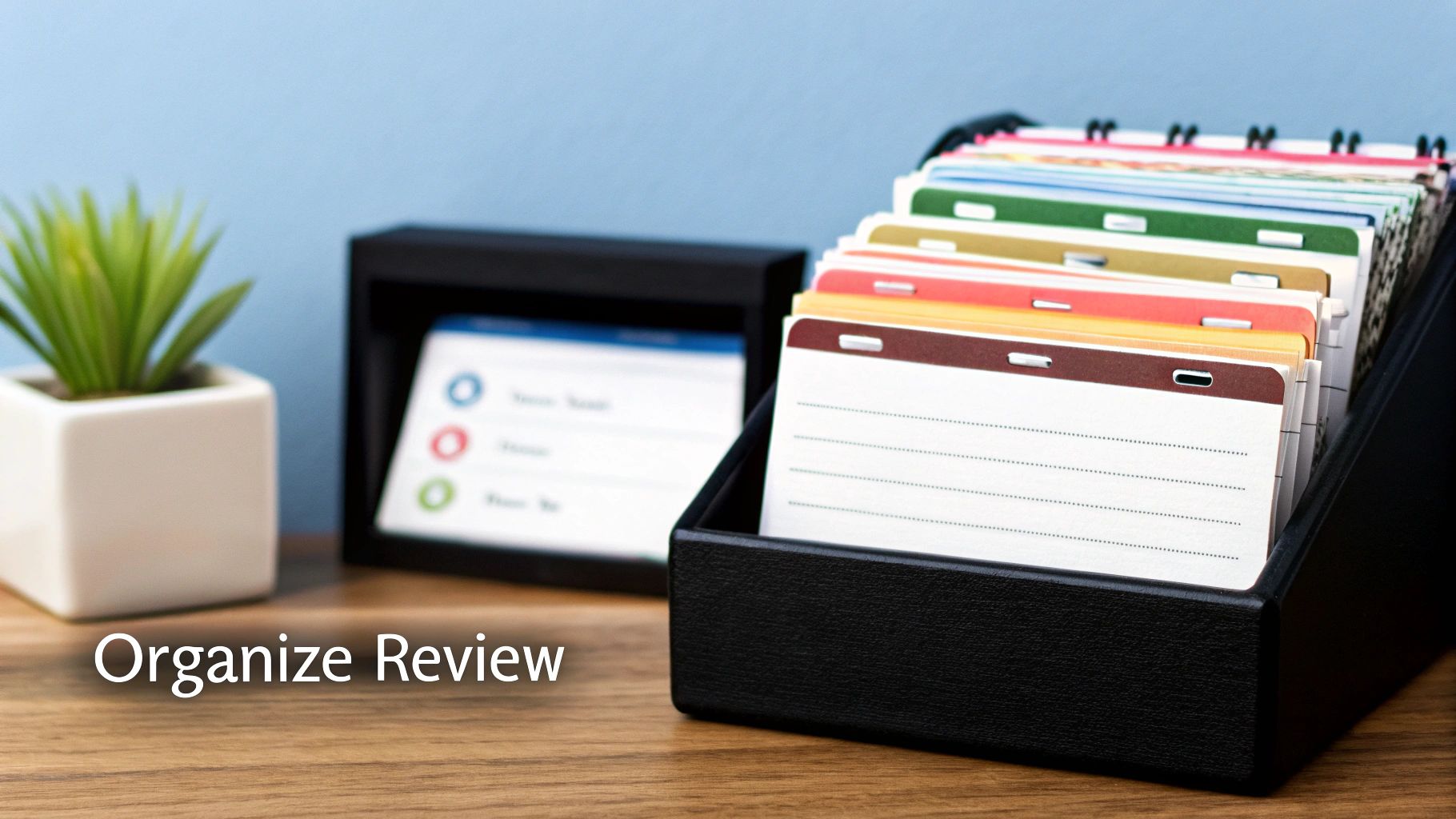Making flash cards is pretty simple: you write a question on one side and the answer on the other. This method, whether you're using classic physical index cards or a digital app, is a surprisingly powerful way to drill facts and concepts into your brain.
Why Flash Cards Are a Secret Learning Weapon
Before we get into the nuts and bolts of making flash cards, you need to understand why they’re so effective. It’s not just about paper and ink; it’s about tricking your brain into learning more efficiently. Flash cards are a powerhouse because they tap directly into how our minds are wired to learn, turning a boring review session into an active mental workout.
This is why they're a go-to tool for almost everyone, from medical students cramming complex anatomy to language learners trying to master new vocabulary. Their success isn't just a fluke—it’s backed by solid cognitive science.
The Power of Active Recall
The main reason flash cards work so well comes down to active recall. When you stare at the question on a card, you have to actually pull the answer from your memory. This is completely different from just re-reading your notes, where your brain gets lazy and just has to recognize the information.
Forcing your brain to dig up information on its own builds much stronger neural connections. Think of it like this: it’s the difference between spotting a friend in a crowd (recognition) and remembering their name out of the blue (recall).
That mental struggle is what cements knowledge in your long-term memory. It’s what takes you from "I think I've seen that before" to "I actually know this."
Embracing Spaced Repetition
Another huge advantage is spaced repetition. Instead of cramming everything at once, this technique has you review information at longer and longer intervals. You’ll see the tough cards more often and the easy ones less frequently.
This smart timing interrupts the natural process of forgetting. Every time you successfully remember something just as you’re about to forget it, you’re basically telling your brain, "Hey, this is important! Don't delete it."
It's no surprise that the demand for these learning tools is booming. The flash card market was valued at around $2.3 billion in 2023 and is only expected to keep growing. That number shows just how many people in school and at work rely on their power. You can explore more data on the flash card market's growth and see for yourself why it’s expanding so quickly.
Crafting High-Impact Physical Flash Cards

Sure, digital tools are convenient, but there's a certain magic to creating physical flash cards. The simple, tactile act of writing information down with your own hands can do wonders for memory retention. But to really make them stick, we need to go beyond just scribbling a term and its definition. The materials you pick and how you lay out the information are just as important as the content itself.
For starters, build them to last. Flimsy paper just won't cut it. I've learned that investing in a sturdy 110 lb card stock is non-negotiable. It ensures your cards can handle being shuffled, tossed in a backpack, and reviewed hundreds of times without turning into a tattered mess. Durability matters, especially when you're in it for the long haul.
Designing Cards for Clarity and Recall
How you organize the info on the card is what separates a useful tool from a jumbled mess. If I can give you one golden rule, it’s this: stick to one single concept per card. It's tempting to cram related ideas together, but that just dilutes the card's power and creates confusion when it’s time to review.
Think of each card as a single, focused question for your future self.
By dedicating one card to one idea, you force your brain to make a clear, distinct connection. This prevents that nagging "I kind of know it" feeling and pushes you toward true mastery of each concept before you move on.
Another game-changer is to paraphrase everything in your own words. Just mindlessly copying a definition from a textbook is a passive, low-impact activity. When you force yourself to translate that definition into language that makes sense to you, you're engaging with the material on a much deeper level.
Making Your Cards Visually Engaging
Your brain is wired to respond to visual cues, so use that to your advantage. Don't just settle for black ink on a white card. A little strategic color can create powerful mental shortcuts that make recall almost effortless. For instance, try using different colored cards for different topics or colored pens to highlight key parts of a definition.
Here are a few simple ways I like to add visual flair:
Simple Doodles: You don't have to be Picasso. A quick sketch of a cell, a stick-figure diagram of a historical battle, or a simple chart can make abstract concepts far more concrete and memorable than words alone.
Mnemonic Devices: Struggling with a long list or a specific date? Create a catchy acronym or a silly sentence and write it big and bold on the card. It feels goofy, but it works.
Color-Coding: This is my go-to organizational hack. Maybe all your vocabulary cards are blue, all formulas are green, and key dates are yellow. It instantly helps your brain categorize information before you even read the card.
When you combine tough materials, focused content, and a few visual tricks, you're not just making flash cards. You're building a personalized learning machine, perfectly tuned to how your own brain works best.
While old-school physical cards have their charm, stepping into the world of digital flash cards can seriously upgrade your study sessions. Platforms like TNote or Anki are built to automate the heavy lifting of your review schedule, making your learning way more efficient.
The secret sauce is their built-in spaced repetition system (SRS). Instead of you manually sorting cards into "I got this" and "I have no idea" piles, the app handles it all. It intelligently schedules when you need to see each card again, strategically showing you the tough concepts more often—right before they slip from your memory.
This automated approach is a huge reason the digital learning market is booming. A recent market analysis estimated the global flash cards market at USD 8.2 billion in 2024, projecting it to hit USD 12.7 billion by 2033. That growth is massively driven by these powerful digital tools. You can read more about the flash card market's expansion to see just how much tech is changing modern study habits.
Taking Your Digital Decks to the Next Level
Digital platforms blow the doors wide open on what a flash card can be. You can move way beyond simple text and create rich, dynamic study aids that paper just can't compete with.
Here are a few ways I like to make my digital cards more effective:
Embed Audio Clips: This is a game-changer for language learners. I add audio of a native speaker's pronunciation right onto my vocabulary cards.
Include Images and Diagrams: Studying anatomy? Instead of trying to describe the clavicle in words, just drop in a diagram and make it a "label this" card. It’s faster and sticks better.
Integrate Videos: For complex processes, like understanding a chemical reaction, linking to a short video clip provides context that a static image or block of text never could.
The real power of digital flash cards comes from their multimedia capabilities. When you engage multiple senses—like sight and sound—you create stronger, more varied connections in your brain. That makes information so much easier to recall when you're under pressure.
Building Your First Digital Deck
Getting started is surprisingly easy. Most apps, including TNote, have a simple interface designed to let you create cards quickly, often right from your existing notes. For instance, TNote has a feature called md2card that instantly converts Markdown text into clean, visually appealing cards.
Here’s a great example of how TNote can instantly turn some plain text into an engaging, professional-looking card.

You can even customize themes to make your study materials not only effective but also nice to look at and easy to share. The bottom line is that modern tools make the process of creating beautiful, functional flash cards almost effortless.
Proven Strategies for Studying with Flash Cards

Knowing how to make flash cards is a great start, but the real learning kicks in when you actually use them. A well-made deck is only half the battle; it's your study technique that turns those simple cards into a serious learning machine. The strategies you pick are what separate a fleeting glance from deep, lasting knowledge.
The heart of effective flash card study is active recall. Before you even think about flipping that card over, you have to force your brain to dig up the answer on its own. It's that mental struggle—the act of pulling the information from memory, not just recognizing it—that forges strong neural connections.
Avoid Common Study Traps
One of the biggest mistakes I see people make is falling for the "illusion of competence." This is when you flip a card too fast, see the answer, and think, "Oh yeah, I totally knew that." But did you really? Or did you just recognize it? To sidestep this trap, always say the answer out loud or scribble it down before you check.
Another classic pitfall is studying your deck in the exact same order every single time. Your brain is smart but lazy, and it will start to remember the sequence of the cards instead of the actual content on them.
Always shuffle your deck thoroughly before each session. This simple action breaks the pattern and forces your brain to recall each concept independently. It’s a small step that leads to much more flexible and robust knowledge.
Implement Smart Review Techniques
To truly make information stick, you need a game plan. Don't just mindlessly drill the entire deck over and over. Instead, try these proven methods:
Study in Both Directions: This is a big one. Test yourself from the term to its definition, and then flip it around and go from the definition back to the term. For example, knowing what "photosynthesis" is from a detailed description is great. But can you define it cold, starting with just the word itself? This ensures you know the material from all angles.
Manual Spaced Repetition: If you’re using physical cards, you can create a simple but powerful system. Sort your cards into piles like "Mastered," "Getting There," and "Needs Work." Hit the "Needs Work" pile daily, the "Getting There" pile every couple of days, and the "Mastered" pile maybe once a week.
Creating Flash Cards for Complex Subjects

Let's be clear: flash cards aren't just for memorizing simple vocabulary. When you really learn how to make them work for subjects like history, biology, or even computer programming, you unlock a much deeper level of understanding. The secret is to stop asking simple "what is" questions and start asking questions that force you to think.
It’s about moving beyond basic definitions. Instead of a card that just asks for a historical date, design one that prompts you to explain the consequences of that event. This small shift forces you to connect ideas rather than just spitting back isolated facts.
Designing Cards That Build Deeper Knowledge
For something hands-on like science, a great card might feature a diagram of a biological process. You could show the unlabeled diagram on the front, and your task would be to draw it from memory, label all the parts, and explain how it actually functions on the back. This turns the card from a passive memory aid into an active learning tool.
Think about how this could work for different subjects:
For History: A card could ask for the "three main causes" of a major war. The answer side would then list and briefly explain each one.
For Programming: The front could pose a specific coding problem. On the back, you’d write out the optimal code and, more importantly, add comments explaining the "why" behind your solution.
For Science: Put a chemical formula on one side and challenge yourself to explain its properties and common reactions on the other.
This strategy completely elevates your flash cards. They stop being a simple memorization tool and become a powerful way to build interconnected knowledge. It’s about creating a web of understanding, not just a list of facts.
The goal is to create prompts that force you to synthesize information. When a card asks "how" or "why," it challenges you to explain a concept in your own words, which is a far more effective way to confirm you truly understand it.
The adoption of these advanced learning methods, both physical and digital, is growing. Right now, North America is leading the flash cards market, largely because of its strong tech infrastructure and an education system that's quick to adopt these tools. If you're curious about the bigger picture, you can read more about trends in the flash card market to see how they're being used globally.
Common Questions About Making Flash Cards
Even after you've got a solid plan, you'll probably still have some questions about making flash cards work for you. Let's dig into a few of the most common ones I hear. Getting these details right can make all the difference between studying smart and just spinning your wheels.
How Many Cards Should I Make?
This is a big one. It's tempting to either make way too many cards or not nearly enough. While there’s no single magic number, a good rule of thumb is to aim for 20-50 cards per study deck.
That range is the sweet spot. It’s enough material for a solid review session without being so much that you feel overwhelmed. If you find a topic is sprawling beyond 50 cards, don't force it. Just break it down into smaller, more focused sub-decks. For instance, instead of one giant "Anatomy" deck, you could have separate ones for the skeletal system, muscular system, and nervous system.
How Often Should I Review My Cards?
Making the cards is just half the battle; knowing when to review them is what truly locks in the information. This is exactly where the power of spaced repetition comes into play.
The core idea is simple: review a card right at the moment you're about to forget it. For brand-new or particularly tough concepts, that might mean looking at them daily. As you get more comfortable, you can start stretching out the time between reviews—every few days, then weekly, and so on.
If you're going old-school with physical cards, you can create a simple manual system. I like to use a few different piles:
Tough Pile: These are the cards you struggle with. Review them daily until they feel familiar.
Medium Pile: For cards you kinda know. Go over these every 2-3 days.
Easy Pile: You've got these down. A quick review once a week is all you need to keep the information fresh.
This approach ensures you’re not wasting time on things you already know and can instead focus your energy where it’s most needed. It’s a game-changer for making your study time more efficient.
Ready to turn your notes into beautiful, shareable knowledge cards in seconds? With TNote, you can transform simple Markdown text into engaging visuals with over 10 different themes. It's the perfect way for students, creators, and educators to make their content truly memorable. Give TNote’s md2card magic a try today